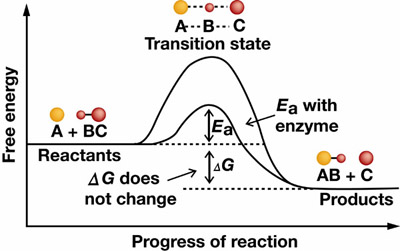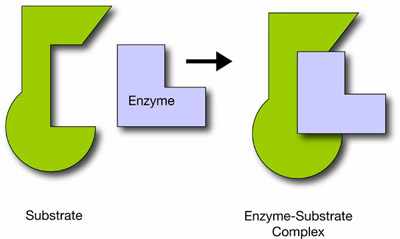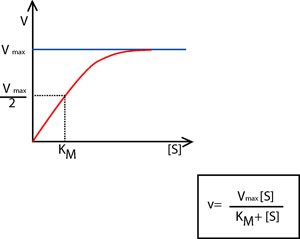 username@email.com
username@email.com
In this lesson, you will review proteins.

Proteins are the stuff of life. As enzymes, they control metabolism and literally make life functions possible. The genetic information found in DNA codes for production of proteins—nothing more and nothing less. Proteins are important structural components, particularly in animals. They are involved in transport, immunity, storage, and function as hormones. The shape of a protein gives it its unique function. The chemical composition of the protein determines its shape.
Proteins are composed of amino acid monomers, which always have a nitrogen-based amine group and a carboxyl group bonded to a carbon or hydrocarbon side chain. The unique side chain of each amino acid is usually designated R. There are 20 unique amino acids. The R group of an amino acid affects its reactivity. Some amino acids have polar side chains, while others have non-polar side chains. Some act as acids, others as bases. The sequence of amino acids in a primary protein determines its ultimate shape.
Amino acids undergo dehydration synthesis reactions to form polypeptide bonds. Polypeptide chains represent the primary level of protein structure.
The secondary structure of a protein results from hydrogen bonding between amino acids in the peptide chain. This leads to twisting or folding of the chain into the alpha helix and the beta pleated sheet shapes.
The tertiary structure results from the hydrophobic effect: a folding of the polypeptide chain due to positioning of polar and non-polar amino acids. Non-polar amino acids are typically inside the three-dimensional structure and polar side chains are on the outer surface. Hydrogen bonds and disulfide bonds stabilize tertiary structure.
The quaternary structure involves a complex grouping of two or more polypeptide chains into a stable, multi-subunit structure. They are stabilized by hydrogen bonding, van der Waals interactions and ionic bonding, and occasionally by disulfide bonds. RUBISCO, the most abundant protein on earth, has 16 subunits. Not all proteins have quaternary structure, and some function as simple primary polypeptide chains.
Proteins are important structural elements, especially in animals. The proteins actin and myosin are the main components of the cytoskeleton. These proteins function in cell movement and support. Actin and myosin are the main component of muscle cells and their interaction results in muscle contraction. Much of the non-cellular matrix of our bodies is composed of protein.
Proteins are also important structural components of cell membranes. Proteins embedded in cell membranes allow the control of movement of materials in and out of cells. Many membrane-bound proteins act as enzymes.
Proteins function in transport. Hemoglobin, the protein found in red blood cells, transports oxygen around the body. Sickle cell anemia is a disease caused by a misshapen hemoglobin protein, which is less efficient at transporting oxygen. Lipoproteins are important in transport of lipids. Within cells, molecules are transported along proteinaceous cytoskeletal elements.
Many hormones are proteins. Insulin and human growth hormone (HGH) are proteins that are now produced by genetically engineered bacteria for use in treating human disease. Protein hormones function by interacting with specific chemical receptors on cells. Hormone receptor reactions are called signal transduction pathways and depend on the physical fit of the molecules.
The immune system produces proteins called antibodies to neutralize invading cells or pathogens, such as viruses. Antibodies function by having the correct fit to the invader it is designed to neutralize. When the immune system encounters a pathogen, it remembers how to produce the correctly shaped antibody to fit that particular pathogen.

Enzymes are proteins that control all of the chemical reactions in cells. They do so by acting as organic catalysts, lowering the activation energy needed for chemical reactions. Their action allows metabolic reactions to occur millions of times faster than they would proceed uncatalyzed. Enzymes are important parts of many metabolic pathways and are vital to both anabolic and catabolic reactions.
Enzymes catalyze reactions by bonding with specific substrates. When enzyme-substrate complexes form, molecules of reactant substrates are positioned in a way that destabilizes binds, allowing chemical reactions to proceed. Such destabilization is called the transition state of a chemical reaction. Substrate is converted to product and released by the enzyme. Enzymes are not used up or changed by the reactions they catalyze.

Enzyme function depends on the physical fit with the substrate. Substrates bind at an enzyme active site in a key-in-lock or hand-in-glove configuration. Misshapen enzymes are the cause of many genetic diseases in humans. It is possible for cells to control enzyme activity by altering the shape of the enzyme or by blocking the binding site.
Many enzymes function with coenzymes, non-protein molecules that must bind to the protein to make it a functional enzyme. Coenzymes often participate in the chemical reaction being catalyzed. Most participate in oxidation reduction reactions. Many vitamins act as co-enzymes, as do ATP and other nucleotides. One of the most important coenzymes is nicotinamide adenine dinucleotide (NAD+), which often acts as an electron acceptor in enzyme catalyzed oxidation reduction reactions.
Understanding enzyme function is vital in modern medicine. Our understanding comes from knowledge of enzyme kinetics, a term used to describe enzyme effects on reaction rates. The rate at which enzyme catalyzed reactions proceed can be calculated from changes in concentration of substrate (chemical reactants) and product. Each specific enzyme substrate complex has a rate constant (kM), which scientists use to study enzyme kinetics. The substrate concentration at which an enzyme catalyzed reaction proceeds at half its maximum velocity determines the kM value of the enzyme. The Michaelis-Menten equation is used to describe the velocity of an enzyme catalyzed reaction at unlimited substrate concentration. Enzyme function can be analyzed via comparison to kinetics of function under the Michaelis-Menten equation.

The rate at which an enzyme functions depends on temperature, pH and ionic concentration, and the relative concentration of enzyme and substrate. Very high temperatures inhibit many important enzymes due to denaturation or change in protein shape. Each enzyme has an optimal temperature range for maximum activity.
Shifts in pH and ion concentration can change the noncovalent bonding patterns and shapes of proteins. Recall that protein shape beyond the primary polypeptide is the result of reactions between amino acid side chains. Hydrogen and polar bonds are readily broken when pH changes. When the non-polar bonds that form enzyme secondary and tertiary structure break, the substrate may no longer fit the active site.
The relative amounts of enzyme and substrate present also affect the rate of activity. When all of the enzyme active sites become bound to substrate, a system is saturated. That means the chemical reaction being catalyzed is proceeding at the maximum rate and adding more substrate will not change that rate. The Michaelis-Menten equation was derived based on conditions of substrate saturation.
Often the products of enzyme-catalyzed reactions will serve as feedback inhibitors for further enzyme activity. Sometimes enzyme activity is regulated by competitive binding at the enzyme active site. Often a feedback inhibitor will be the product of some metabolic pathway initiated by the enzyme being inhibited.
Allosteric enzyme regulation occurs when binding of a signal molecule at an allosteric site changes the shape of an enzyme. Binding by allosteric inhibitors prevents enzyme-substrate interaction. Allosteric activators bind to allosteric sites to change protein shape and actually produce the key-in-lock enzyme substrate fit. In allosteric activation, the enzyme will not function until the signal molecule changes the enzymes shape. Allosteric enzyme regulation is also a part of many complex metabolic pathways.

Why is pH important to protein function?
A is the correct answer. Protein function depends on shape. Changes in pH mean changes in H+ concentration, which impacts protein function by disrupting H bonds. H ions do not act as allosteric inhibitors or activators; do not competitively bind to enzyme active sites; and do not act as coenzymes to activate enzymes.